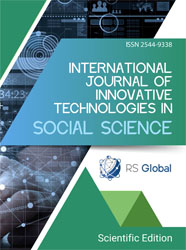THE ROLE OF LANGUAGE IN NEWS DISCOURSE
Abstract
In the article, first of all, the concepts of fact and accurate information are disclosed that make up the text of the news. Because an event worthy of news status should be taken as fact. Otherwise, high-quality media will refuse to distribute the material. In addition, it is very important to accurately convey the fact to the public. That is, the maximum proximity of the prepared material to the event accepted as fact increases the accuracy of the information. First of all, a journalist needs to have a perception of the event, to have sufficiently comprehensive information, to correctly understand reality, to have impartiality, objectivity and a sufficient lexical and grammatical base to express his formed opinion. The article also analyzes the important points to pay attention to in the choice of words and sentences in the preparation of news material, depending on the type of media. Thus, different ways of delivering information in different media also have an impact on news materials. For example, the simplicity and clarity of words, the size, and structure of sentences are approached differently, depending on whether the real audience is a reader, listener, or viewer.
References
Çaplı, B. & Hüseynli, N. 2017. Televiziya jurnalistikası. Bakı: Avropa Şurası.
ƏZİZOVA, P. Linqvistikada mətn anlayışı/Dil və ədəbiyyat, Beynəlxalq elmi-nəzəri jurnal 2(110), Bakı, 2019. səh. 97-99.
Məhərrəmli, Q. & Kərimova, A. 2017. Radio jurnalistika. Bakı: Avropa Şurası
Acholonu, Regina. 2014. Techniques of Television News writing and Production
https://www.researchgate.net/publication/313160854
Fang, Irving. 1991. Writing Style Differences in Newspaper, Radio, and Television News. University of Minnesota. Monograph Series No. 2.
Mills, J. 2004. The broadcast voice. Burlington, MA: Focal Press.
Powers, E. & Haller, B. 2017. Journalism and Mass Communication Textbook Representations of Verbal Media Skills: Implications for Students with Speech Disabilities/ Journal of Media Literacy Education 9 (2): 58 – 75 https://www.researchgate.net/publication/320874033
Rantanen, Terhi. 2005. The message is the medium: An interview with Manuel Castells Global Media and Communication; 1: 135-147
Sambit, Mishra & Ruby, Nanda. 2017. Television Journalism. Odisha State Open University. Sambalpur.
Vlad, Davian. 2018. The main principles and techniques of radio news writing. /Social sciences and education research review (5) 2: 78-85
Wenger, D. H. & Potter, D. 2015. Advancing the story: Broadcast journalism in a multimedia world. Washington DC: CQ Press.
White, Ted & Barnas, Frank. 2010. Broadcast News: Writing, Reporting, and Producing 5th Edition
Dautova R.V. Anokhin A.I. 2018. Ghanri i modeli novostnoy telejurnalistiki: uchebnometodicheskoye posobiye dlya magistrov. Kazan: Kazan univ.
Yerofeyev S.V. 2018. Nastolnaya kniqa mediavolontyora. M.: Moscow, “Mosvolontor”
https://echo.msk.ru/news/31563.html
Ahmad Valiyev, Rahib Imamguluyev, Ilkin Gahramanov, Staff Selection with a Fuzzy Analytical Hierarchy Process in the Tourism Sector, January 2022, In book: 11th International Conference on Theory and Application of Soft Computing, Computing with Words and Perceptions and Artificial Intelligence - ICSCCW-2021, DOI: 10.1007/978-3-030-92127-9_59
Views:
763
Downloads:
413
Copyright (c) 2022 Mehriban Monsumova

This work is licensed under a Creative Commons Attribution 4.0 International License.
All articles are published in open-access and licensed under a Creative Commons Attribution 4.0 International License (CC BY 4.0). Hence, authors retain copyright to the content of the articles.
CC BY 4.0 License allows content to be copied, adapted, displayed, distributed, re-published or otherwise re-used for any purpose including for adaptation and commercial use provided the content is attributed.











